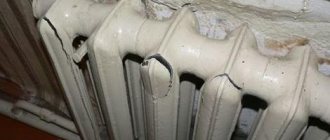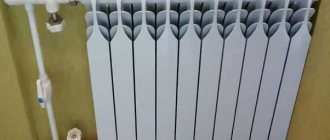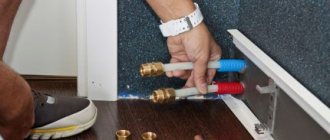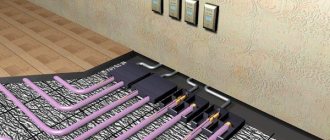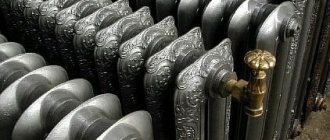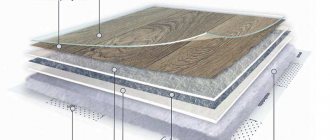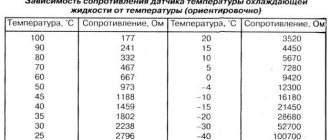In ancient times, during the winter cold, open fires provided pleasant warmth to the house. Although they are very attractive, they require frequent maintenance and the addition of new firewood, which burns out quickly. Over time, brick fireplaces and stoves appeared, which were much more functional - they held heat longer, smoked less and, no less important, created comfort in homes.
Today, traditional heating methods are slowly fading into oblivion, and fireplaces are more of a decoration for elegant living rooms than a means of heating. What methods of heating houses are chosen most often today? Of course, the priority today is water heating, which is carried out from a central boiler room or autonomous boilers. But underfloor heating and even “warm wall” heating are also gaining popularity. What is better: a water heated floor or radiators, what are the advantages and disadvantages of each type of heating - we will look at it in this article.
Which is better: heated floors or radiators?
Many people who are building a house or doing major renovations are wondering what is better: heated floors or classic radiators? As it turns out, the solution is not so simple! Therefore, before making your final choice, you need to objectively consider which system has more advantages and which type of design is best suited for your home.
Underfloor heating options
There are three main types of underfloor heating, which differ in the heat source and heating method:
- Water;
- Electrical;
- Infrared.
Water heated floors are flexible pipes through which heated water circulates. Its temperature should be 30-35 degrees. The main is usually laid in a screed, although there may be options depending on the type of pipe.
Electric heated floors are a cable that is laid under any surface. They can be mounted in screeds or special plastic substrates (see photo). There are options in the form of mats that can be laid under a screed or finishing floor covering.
Plastic underfloor heating
Infrared (film) heated floors are squares of film. When laying, they are connected to each other into a single system. This type of heated floor does not need to be laid in a screed; you can immediately lay the finishing coating on it - laminate, linoleum, etc.
A brief comparison of radiator heating and underfloor heating systems
| Heating radiators | Water heated floor | |||||||
| Cost of setting up the system | cheaper labor and materials | more expensive labor and materials | ||||||
| Economical operation | less economical | 10 - 20% per season | ||||||
| Requirements for floor finishing materials | you can use any materials | there are restrictions, it is preferable to use ceramic tiles | ||||||
| Difficulty in carrying out repairs | repair and modernization of the system is possible | no repair possible | ||||||
| Inertia of the heating system | low | high | ||||||
| Impact on microclimate | warmer air is at the top of the room | there is warmer air at the bottom of the room, your feet are always warm | ||||||
| Influence on the interior | the appearance of devices is constantly improving, there are separate types of radiator designs | the absence of radiators expands some possibilities | ||||||
| Effect on the human body | there are practically no differences | there are practically no differences | ||||||
Types of radiators
Radiators are divided into three types:
- Aluminum;
- Bimetallic;
- Cast iron.
Aluminum radiators are the most common. The entire body is made of aluminum, due to which they have good heat transfer and low weight. Their disadvantage is low strength.
In bimetallic radiators, the body is made of aluminum, but inside there is a core made of steel or copper. It gives strength to the system and allows it to withstand high pressure and temperature changes.
Cast iron radiators are a classic. Despite their heavy weight and inertia, they are still popular. Cast iron batteries take a long time to warm up, but cool down slowly and retain heat well. Modern versions are made in different styles, from baroque to high-tech.
Radiators
The advantage of the classical method is the low cost of installation compared to heated floors. And the main disadvantage is the uneven distribution of heat. Much depends on the type of radiator and how it is connected. The coolant of the effective battery is about 70 degrees. It is the high temperature that allows the radiator to have compact dimensions. The lower the coolant temperature, the more radiators are required to heat one room. What other advantages and disadvantages do the classics have:
the radiator and heating pipes are always visible, which affects the interior design;

- The performance of the radiator is easily regulated by a thermostatic head, the temperature change will occur within an hour, while in a heated floor system you will have to wait several hours;
- Due to the fact that the entire system is visible, it is easy to repair and replace some elements with more efficient ones. The warm floor is installed into the concrete screed once and for all;
- finned radiators give off heat by convection by 80%, the rest by radiation;
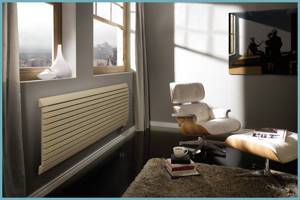
Ribbed radiators in the interior
- convectors transfer heat by convection, which leads to increased dust circulation in the room;
- Aluminum radiators emit only 8% of heat, the rest is convection;
- panel radiators radiate 35%, the remaining percentage is convection.
What are we going to warm – our head or our feet?
The main difference between heated floors and radiators is how exactly they warm up the room. And the microclimate and comfort for humans largely depend on this.
A warm floor heats the air below, which rises and gradually cools. Having reached the ceiling of the room, it cools to the maximum, after which it falls down again.
Radiators quickly heat the air, which rises along the walls, cooling. After it rises to the ceiling, its temperature drops, it sinks down in the center of the room. It is this part of the air that warms you.

Temperature distribution when heating with heated floors and radiators.
Features of heating with radiators
All apartments have radiators; these are quite efficient devices that will require heaters only during the off-heating season. Of course, in a private house with individual heating there are no such problems - the residents themselves decide when to turn the heating on and off. But what about whether heating radiators are effective and practical in private homes in general? Or, following modern trends, is it better to give preference to heated floors?

Correct installation of the radiator
Installation and installation - prepare for the inevitable
You will probably agree that any repair or construction work is an inconvenience and a headache. As a Russian satirist said:
Repairs cannot be completed, they can only be stopped.
Mikhail Zhvanetsky
Warm water or electric floors are laid in a screed. Therefore, it is advisable to equip it before finishing work begins.
If the repairs have already been made and finishing work has been carried out, you will have to dismantle the old flooring - parquet, laminate, tiles. After this, you need to make a so-called “pie” - lay three layers of thermal insulation. Then you need to lay the cable or pipes and fill the screed.
With an infrared film floor, everything is somewhat simpler. It can be laid under the finishing coating - parquet, floorboards, carpet, linoleum, laminate. But the old floor still needs to be removed.
Installing and connecting radiators is much easier than heated floors. Typically, it will not take more than a day to install a radiator heating system in one room. To do this you will need:
- Lay heating pipes;
- Hang radiators;
- Connect the entire system with fittings.
As you can see, from the point of view of ease of installation, radiators significantly outperform heated floors.
Warm floor
A warm water floor is a concrete floor with a built-in piping system. This cake is placed on a cushion of insulation. Heat from the floor is distributed evenly over the area of the room. Let's consider the advantages of this type of heating:
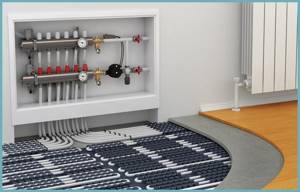
The disadvantages include complex and expensive repairs in the event of a leak, which is associated with the pipeline laying technology. Long heating and cooling of the floor. Small children get tired quickly, since their metabolism proceeds faster, the child will be constantly hot.
Advice. Installing an electronic thermostat will allow you to smoothly adjust the temperature according to weather conditions.
Having weighed all the advantages and assessed the disadvantages, it is worth making the only right decision in choosing a heating system for a private home. In any case, success is guaranteed by correct calculation and installation, then the disadvantages will become advantages.
Count your money - economical operation
At the moment, electricity is not cheap, so not everyone can afford to heat a house or apartment with electric and infrared heated floors. But if there is no other option (central heating, gas, solid fuel boiler), then there is no alternative.
In the case of water heating, everything is more complicated. Some “experts” believe that the costs of heating with radiators and warm water floors are the same:
Take it into account or don’t take it into account... how much heat a closed system (house) loses, that much must be replaced... in any way.
Unknown from the Internet
But in reality this statement is false. If you heat your house with radiators, the heating will be uneven. The heated air will be at the top, under the ceiling. And there are the greatest heat losses. 25-30% of the heat escapes through the ceiling and roof.
If you heat using the floor, the heating occurs more evenly. The only negative is that heat also escapes through the floor. Heat loss is about 10-15% of heat, that is, 2-2.5 times less. But that's not all.
When laying a heated floor, it is imperative to make a “pie” that prevents heat loss. Of course, some part of it goes to the basement or to the residents of the lower floor, but no more than 5% of the total.
As for the electric heated floor, it is also insulated using a “pie”. Therefore, it is more profitable for them to heat the room compared to electric radiators or convectors.
Conclusion
A warm water floor is much more profitable than a radiator heating system. Warm electric floors are more expensive to operate than heating with water, but more profitable than heating with other types of electrical appliances.
Purchase and installation costs
When making a choice between a heated floor or a radiator, you should note that the preliminary costs for the first option for heating a house require more money. Purchasing the necessary components to install a conventional heating system is much cheaper.

It is worth considering in more detail the costs of installing both systems. First of all, it should be noted that when installing heated floors, the level of the floor covering rises by 10 cm. For rooms with low ceilings, this is of no small importance, since you should buy furniture of appropriate sizes.
For heated water floors without radiators, you will need to spend money to perfectly level the base. Heated floors are installed only on an absolutely flat surface. Installation and connection of heated floors is labor-intensive and responsible work. It is better to use the construction services of professionals than to eliminate defects after installation.
In order for the structure to provide maximum heat, you should worry about thermal insulation. A layer of waterproofing is laid on the concrete base with an overlap on the walls; the top is covered with a heat-insulating film. To prevent the future coating from cracking when heated, a damper tape made of porous material is attached around the perimeter of the room.
Then the pipes themselves should be laid. “Snake” is cheaper. It can be attached with clamps to a metal mesh. But in reality, it is much more convenient to use a ready-made pipeline system - a kind of “carpet” with bosses. When laying it, it is necessary to take into account the width of the step (a gap of 10 - 35 cm), as well as the required distance from the wall to the outer row (equal to at least 7 cm). After the entire system is connected and crimping is done, a self-leveling screed is poured. If a special “carpet” is used, a screed is not necessary. The surface of the pipes is covered with foamed polyethylene and a decorative coating is applied on top.
Not every material is suitable as a finishing coating for floors. Floors made of materials that have high thermal conductivity are acceptable. Carpet and laminate are suitable. But the heated floor under the parquet does not fully perform its heating function. As for conventional heating, the highest costs fall on the radiators themselves, connecting pipes, and the purchase of necessary fittings. And even here you don’t have to spend a lot of money. The cheapest option for radiators is cast iron. Modern aluminum and metal ones are a little more expensive.
An advantage in favor of installing conventional heating is that it is absolutely easy to buy components for it. Construction stores and markets sell all sorts of radiators and other components. The prices will suit the taste of both the most modest and the most demanding buyer. In addition, installing a heating system is a completely simple job. The only thing that deserves attention is the need to maintain strict horizontality of the entire system.
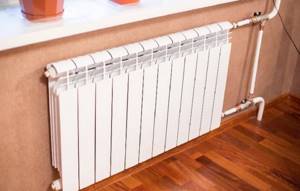
Radiators can be repaired, and if they leak, they can be replaced with new ones. The same applies to other parts of a conventional heating system. But if a leak is detected in the “warm floor” system, you have to break the floor covering and replace the entire “carpet” with a new analogue.
Maintainability
Here, perhaps, everything is clear. What is in sight, what is more convenient to approach, is also more convenient to repair. Of course, in order to bleed air from a heated floor, you don’t have to remove the covering and hammer the screed with a jackhammer or hammer drill. But what if a cable breaks or a pipe cracks?
With heating radiators everything is simpler. The only inconvenience may arise if the pipes are hidden in the wall. But in any case, if there are problems with the radiator heating system, they are much easier to fix.
Are there real savings when using heated floors?
But where can such savings come from if, theoretically, the same amount of heat should be expended to heat any room, regardless of the heating system?
When using a heated floor, heat savings become possible due to the specifics of its distribution. When using radiator heating, heat is constantly in motion - it rises up from the radiator, then cools near the ceiling and falls down to the floor, but when using heated floors, there is practically no circulation, and the highest temperature is located near the floor itself. In a heated floor system, the temperature of the coolant most often does not exceed 55 degrees, and in a radiator heating system the temperature often reaches 90 degrees.
But there is no need to jump to conclusions. The difference in coolant temperatures of the two systems under consideration is not in itself an indicator of savings. In order to maintain the same temperature in the room, the boiler in both cases expends approximately the same amount of energy, in accordance with the elementary laws of physics. In this case, it becomes unclear where the savings might come from?
Inertia of heated floors and radiators
It takes some time for any heating system to start giving off heat after switching on. In the same way, it gradually cools down after being turned off. Warm floors warm up the room much faster, because they are located over a large area. To warm up a room, house or apartment with radiators, you will have to wait.
How quickly does a heated floor heat up?
Warm water floors heat up and cool down the slowest. This is because they first need to heat the water, and then the screed in which the pipes are laid.
The second fastest heating and cooling are electric heated floors laid in a screed. The wire with the heat-generating element heats up almost instantly, you just have to wait until it warms up the screed.
An electric heated floor, laid on a special substrate, immediately begins to heat the floor covering. In terms of heating and cooling speed, it is the same as infrared.
Heating radiator heating speed
If you have a central heating system, then to turn it on, just turn the valve and hot water will flow through the pipes. It will quickly displace the remaining cold water and the radiators will immediately begin to warm up.
With individual heating, you first need to warm up the water that is in the heating system circuit. Therefore, the batteries will warm up more slowly. According to the heating speed, the types of radiators are arranged in the following order:
- Aluminum;
- Bimetallic;
- Cast iron.
It is impossible to draw an unambiguous conclusion from the above. Too many factors influence the heating system's heating rate. It also depends on the speed and type of coolant in the system, the temperature in the room, and its size.
The fundamental difference between underfloor heating and a boiler with radiator batteries
The main difference between heated floors and radiators is the principle of operation. A warm floor contains heating elements that act on the ceiling, which warms the room. It warms up evenly, which means that people can walk barefoot and not be afraid of catching a cold. Warmed air masses move upward, replacing cold, heavy masses moving downward.
Heating of the room occurs according to an inertial scheme - the concrete slab is heated, which then warms everything else. For those who do not like to wait a long time, it is better to opt for heating with a boiler, pipes and radiators
But this is not such a serious feature as to focus attention on it, because in cold seasons houses are heated around the clock
“But the cold comes from the windows, radiators are installed in order to avoid these heat losses, and now everything is removed from under the windows!” the meticulous owner will say. Of course, this is true, so small radiator batteries or so-called thermal paths are used together, which warm the window area and eliminate fogging of the glass.
Microclimate is our everything!
Any heating system, be it heated floors or radiators, affects not only the temperature. There are other factors that are important to a person.
Air humidity
The optimal level of indoor humidity is almost as important as temperature. And it is necessary to support it.
With a radiator heating system, the air in the room is mixed at a higher speed than with underfloor heating. In the center of the room it is lower than near the walls, especially at the bottom, at the level of 0.5-1 meters. There the moisture concentration is greater, and higher - less. Accordingly, sometimes it is not enough for breathing.
Warm floors, on the contrary, maintain water molecules and steam droplets at a certain level, since the air from them rises throughout the entire area of the room. In terms of humidity levels, they are preferable.
It's all dust!
For some reason, the association “radiator = dust collector” has stuck in our heads. And we think that's bad. But if you dig deeper? The more dust settles on the radiator, the cleaner the air in the room! In addition, batteries are made of metal and dust is retained on them due to static electricity. It turns out that the radiator is a kind of air filter.
With heated floors, everything is not so good. Dust settling on it rises up along with air currents. It constantly flies around the room and gets into your respiratory tract. This is especially unpleasant and sometimes dangerous for allergy sufferers.
Drafts
Radiators provide a stable strong air flow only above them. They are able to cut off or somewhat smooth out the draft that comes from a vent or window that is exposed to winter ventilation. But if the air flow is strong enough, the radiator cannot cope with it.
A warm floor, due to its large surface, can “calm down” a medium draft. When cold air enters a room, it immediately mixes with warm air and rises with it. Thus, the warm floor kind of knocks it down.
Dangerous for health!
Heated floors have one big disadvantage - addiction. Our body is designed in such a way that our feet get cold the most, mainly from cold surfaces. Accordingly, our body directs maximum heat to them, trying to warm them up. Due to this, blood flow accelerates and blood supply to the brain improves.
If you are constantly in a room with a heated floor, you are comfortable and your body does not pay enough attention to your feet. But when you leave it, your “heating system” does not turn on as it should. And my feet begin to freeze more.
As studies have shown, heated floors have their contraindications. It may cause flare-ups in people with:
- Hypertension;
- Asthma;
- Gynecological diseases;
- Allergies;
- Varicose veins.
Radiators, on the contrary, maintain the natural temperature distribution for humans. The feet are in cooler air, the head is in warmer air.
Ventilation
In rooms with fresh air ventilation, it is necessary to control the flow of incoming air. Heated floors do not cope with this task, since they can direct the effective flow of heat in the desired direction.
Installing a radiator in front of the supply duct can solve this issue. The flow of hot air it creates will mix with cold air and the room will have a comfortable temperature. This way it will also relieve you from drafts.
Disadvantages of conventional batteries (radiators)
Fortunately, radiators have far fewer disadvantages than advantages.
- The biggest one is the unfavorable temperature distribution in the room. Unlike underfloor heating, in a room heated by radiators, most of the warm air rises. Unfortunately, in this case, the heat is at head level and above, and the coldest area in the room is at our feet, which does not contribute to comfort, but does contribute to hardening. Of course, this is not the best solution in a house where there are small children who spend a lot of time sitting on the floor rather than standing. In this case, you will have to think about buying carpets or rugs.
- In addition, radiators do not contribute to the well-being of people with allergies. According to research, the phenomenon of convection, that is, an increase in air movement, also increases the movement of dust particles, and with them the harmful dust mites.
- In addition, intense heating dries out the air, which can lead to discomfort and drying out of the nasal mucosa. Therefore, during the autumn-winter period, dust purifiers and air humidifiers should be used, which will help to significantly reduce these problems.
- You also need to know that radiators can only work with high-temperature boilers and water heating systems. Heated floors, on the contrary, work with low-temperature heat sources, such as condensing boilers, heat pumps and solar collectors.

“There is no arguing about taste,” says a well-known saying. In the same way, there is no point in arguing about whether radiators or heated floors are better. For each of us, the best solutions may be completely different. In order to correctly choose which is better between radiators and heated floors, you need to carefully analyze not only the advantages and disadvantages of both solutions, but also financial possibilities. In addition, the type and character, thermal insulation of the building in which this or that heating system will be located are important. Only a thorough, comprehensive analysis will help you make the right decision and enjoy a cozy atmosphere in the winter.
Interior
Warm floors do not in any way affect the interior decoration and design of your room. They are hidden under the floor covering; their existence can only be guessed by the presence of a temperature regulator or controller.
Radiators cannot be completely hidden from prying eyes. Of course, you can try to refine the appearance, choose a model that matches the interior design, or simply hide the radiator. But in any case, from an aesthetic point of view, warm floors win.
Which system is easier to repair?
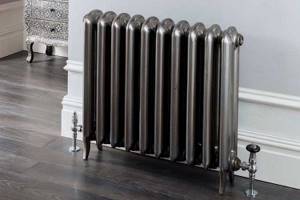
When considering the issue of maintainability of boiler equipment, you need to understand which elements in it are most at risk of failure. If we take into account only the radiators themselves and the heated floor pipes, hidden in the thickness of the concrete, removing the convector from the wall and simply replacing it is much easier than disassembling the screed. In the latter case, you also need to understand where to look for a breakdown.
A professionally made floor may not cause problems at all, because the water pipe itself practically does not wear out and does not corrode, which cannot be said about batteries, especially those made of steel. The reliability and maintainability of other heating parts for both designs depends only on the quality of the equipment, components and operating conditions.
It is important to pay special attention to the coolant that will be used in the operation of the heating circuit. The more aggressive, hard and saturated with salts the water is, the faster it will damage different parts of the structure. In this case, it is recommended to use good filters.
Will you overpay?
As for prices for materials and equipment, it all depends on your preferences. Expensive designer radiators will cost much more than cheap pipes and underlay for a warm water floor. But general trends can be identified.
Laying and pouring screed over water and electric heated floors significantly increases the cost of installation. Therefore, these two options are on average more expensive than the others.
Film infrared heated floors in themselves are not cheap. But its installation does not require a large amount of additional materials. In general, it is cheaper than previous options.
Whatever radiators you decide to install, the installation cost will be the same. The only difference is the price of the batteries themselves, pipes and fittings. But on average, purchasing, installing and connecting heating radiators is cheaper than installing a heated floor.
Which is cheaper to install?
In terms of the cost of materials, heating radiators are more profitable than heated floors.
Expert opinion
Sergey Permyakov
Heating systems engineer
For example, let's compare the prices of equipment necessary to obtain a thermal power of 1 kW .
- Bimetallic or aluminum radiators, 6 sections - price 3,400 rubles.
- Cast iron batteries, 9 sections - 4500 rub.
- Electric warm mat Warmstad — 6100 rub.
- Water floor with a laying step of 15 cm, Rehau pipes - 6,600 rubles.
In addition, for proper installation of a heated floor, you will need insulation, a special screed and reinforcing mesh, as well as a manifold group and a pump, which will add to construction costs.
On average, the difference between these systems in cost is 30-40% in favor of radiators; it is not for nothing that such heating is considered a more budget option.
Combined system – expert opinion
You can combine heating with radiators and heated floors. In many cases, this will be more convenient and economical for several reasons.
If you have a two-story house or apartment, then it makes sense to install heated floors on the first floor, and install radiators on the second and subsequent floors. Heated air from the first floor will warm up the floors between it and the second. Due to this, heating the upper floor will not require large heating costs.
The operating temperature of a water heated floor is 30-35 ° C, and that of radiators is 55-90 degrees. You can make an interesting diagram for connecting heated floors and radiators. In simple words, run the water first through the radiators, and then, when cooled, onto the heated floor. How to implement all this - see the diagram.

Connection diagram for heated floors and radiators in one system.
In a one-story house or apartment, it makes sense to install separate radiators and heated floors. Do you agree that when you get out of the shower, it’s much more pleasant to step on warm tiles with your bare feet rather than cold ones?
It also makes sense to equip the nursery with warm floors. Your child will feel comfortable playing with toys on the floor.
But in the kitchen it makes sense to leave radiator heating. You don't spend much time there, and besides, you don't stand still. Yes, and electrical appliances emit heat, especially the stove and oven. Therefore, it is useless to spend money on expensive heated floors, which will waste your budget.
Combined system
You can combine two types of heating as follows:
- warm floor in addition to radiators;
- heated floors as the main source of heating, and radiators as an auxiliary one.
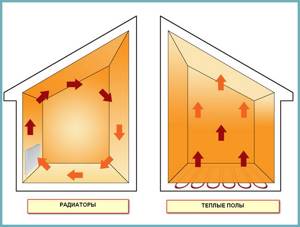
Heating the air with a radiator and underfloor heating system
Often, to ensure comfort in two-story private houses, warm floors on the ground floor are used as the main source of heating, and the upper floor or attic is heated with radiators. This combination allows you to take full advantage of the two systems. In the bedrooms, the temperature can be adjusted at night and during the day. And on the ground floor it warms up the room well.
If the heat loss of the room is large, then a combined system is installed.
Let's sum it up: which is better, warm floors or radiators?
If you read to the end of this article, you probably realized that there is no clear answer. In one case it is necessary to install heated floors, in the other - radiators. To summarize everything written above, we have compiled a comparison table.
| Index | Water floor | Electric floor | Infrared floor | Radiators |
| Efficiency | ✓ | ✓ | ✓ | × |
| Easy to install | × | × | ✓ | ✓ |
| Economical | ✓ | × | × | ✓ |
| Maintainability | × | × | ✓ | × | ✓ |
| Warm-up speed | × | ✓ | × | ✓ | ✓ | × |
| Air humidity | ✓ | ✓ | ✓ | × |
| No dust | × | × | × | ✓ |
| Fighting drafts | ✓ | ✓ | ✓ | × |
| Health safety | × | × | × | ✓ |
| Easy to install | × | × | ✓ | × | ✓ |
| Price | × | × | × | ✓ |
We hope that after reading the article you were able to answer the question of what is better, warm floors or radiators. If you have any questions or want to express your opinion, you can do so in the comments.
Don't forget to share the post with your friends!
What to choose for heating your home?
Now that we have found out all the advantages and disadvantages of this or that method of heating a room, we can draw some intermediate results.
- Price. It’s clear here that radiators are cheaper than heated floors of any type.
- Efficiency during operation. The radiators are installed along the walls and under the windows, as a result of which heat loss through these structures significantly increases. The efficiency of heated floors is 10-30% higher than that of a radiator heating system.
- Uniformity of heat distribution in space. Here the “palm” is given to the “warm floor” system.
- Flooring. For heated floors, unlike a radiator heating system, not any coating is suitable. Furniture and non-natural types of coverings, due to their low thermal conductivity, create a noticeable obstacle to heating the room. Radiators win in this “nomination”.
- Maintainability. We have already determined above that radiator heating is better to repair due to its availability.
Connection diagrams for heating radiators
There are only 3 such schemes, each of them has its own characteristics, pros and cons.
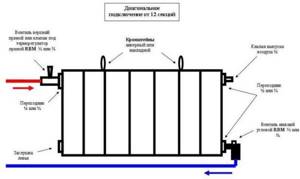
Diagonal connection from 12 radiator sections
Option #1. Single-pipe
Here the radiators are connected in series, making installation much easier and requiring much less consumables. A pipe running under the radiators goes from the boiler through all the rooms and returns to it. The radiators are connected via lower pipes. The liquid fills the sections of the batteries, giving them heat, falls and goes through another pipe into the same pipe.
Video - Advantages of single-pipe heating systems
As for the disadvantages of the scheme, these include, first of all, rather low heat transfer, because the coolant in this case enters each battery after it has already cooled down. As a result, the further the room is from the boiler, the colder it will be.
Option #2. Two-pipe
There are 2 pipe circuits here at once - through one the coolant is supplied to the radiators, and through the other it is removed, due to which the thermal energy is distributed evenly throughout the house.
Note! This scheme has many advantages, since each individual room can provide its own temperature regime. And if repairs are required, there is no need to turn off the entire heating system. In a word, the scheme is much better than the one described above.
Video - Connecting radiators in a two-pipe system
About methods of connecting pipes to radiators
How effective such heating will be largely depends on the way the batteries are connected to the pipeline. There are several of these methods; let’s look at the features of each of them.
Table. How batteries are connected to heating pipes.
| Connection method | Short description |
| Lateral | The supply and return are connected on one side of the heating device (top and bottom, respectively; you can swap them, but the heating efficiency in this case will decrease by approximately 7 percent). |
| Lower | Can be used in both one- and two-pipe systems. Experts believe that this is the most ineffective method. |
| Diagonal | The supply is connected from above on one side, and the “return” from below on the other. The best method if we consider it from the point of view of heat transfer efficiency. |
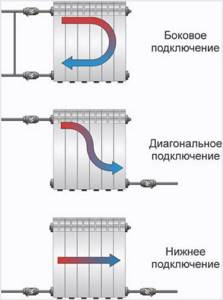
How to connect a radiator to pipes
A few more words about radiator heating
Due to the fact that heated air rises upward due to the laws of physics, the air temperature near the ceiling and next to the radiators can be quite high. In other words, heating will occur in areas that do not really need to be heated. But the floor temperature in this case will be only 16-17 degrees, that is, not the most comfortable for the feet. We conclude: with radiator heating, heat is distributed irrationally.
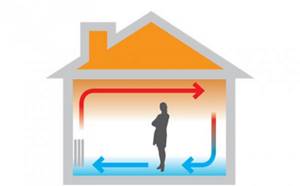
Operating principle of radiator heating
The air that passes through the batteries is warmed up and distributed throughout the room. Simply put, it circulates, and dust rises with it.
On a note! For radiator heating, it is very important to correctly calculate the number of sections for each device. After all, each section can heat only a limited area and the efficiency of the entire system depends on the number of sections in the batteries.
